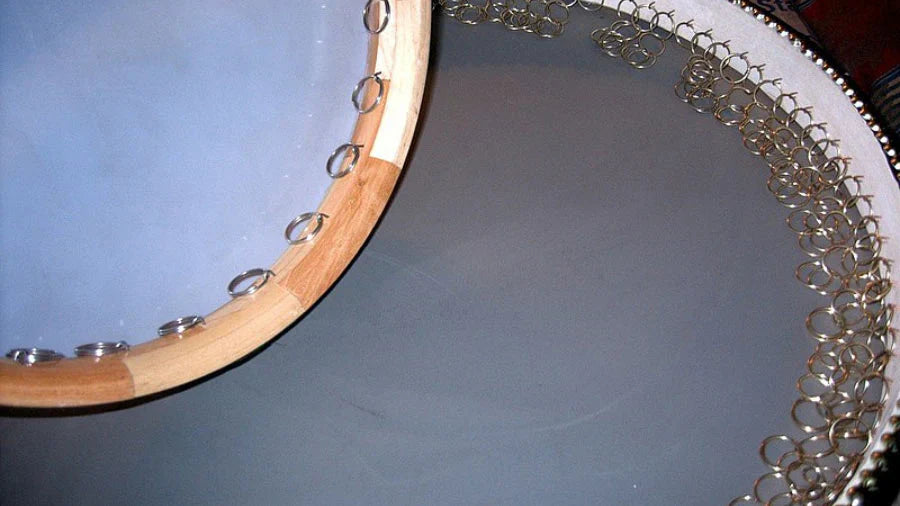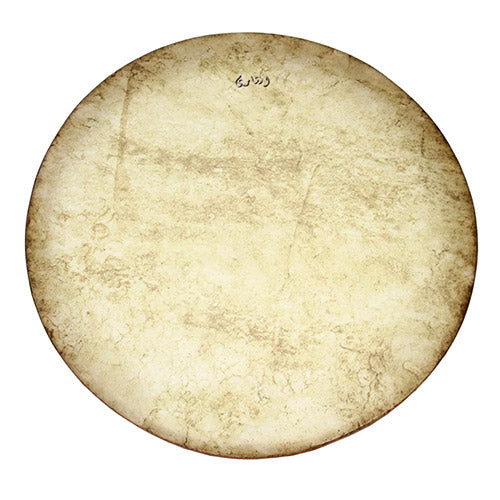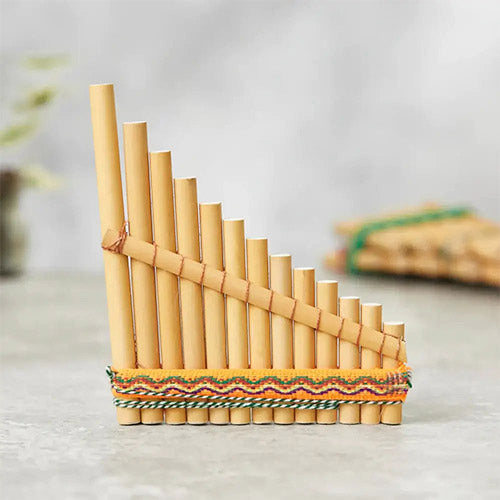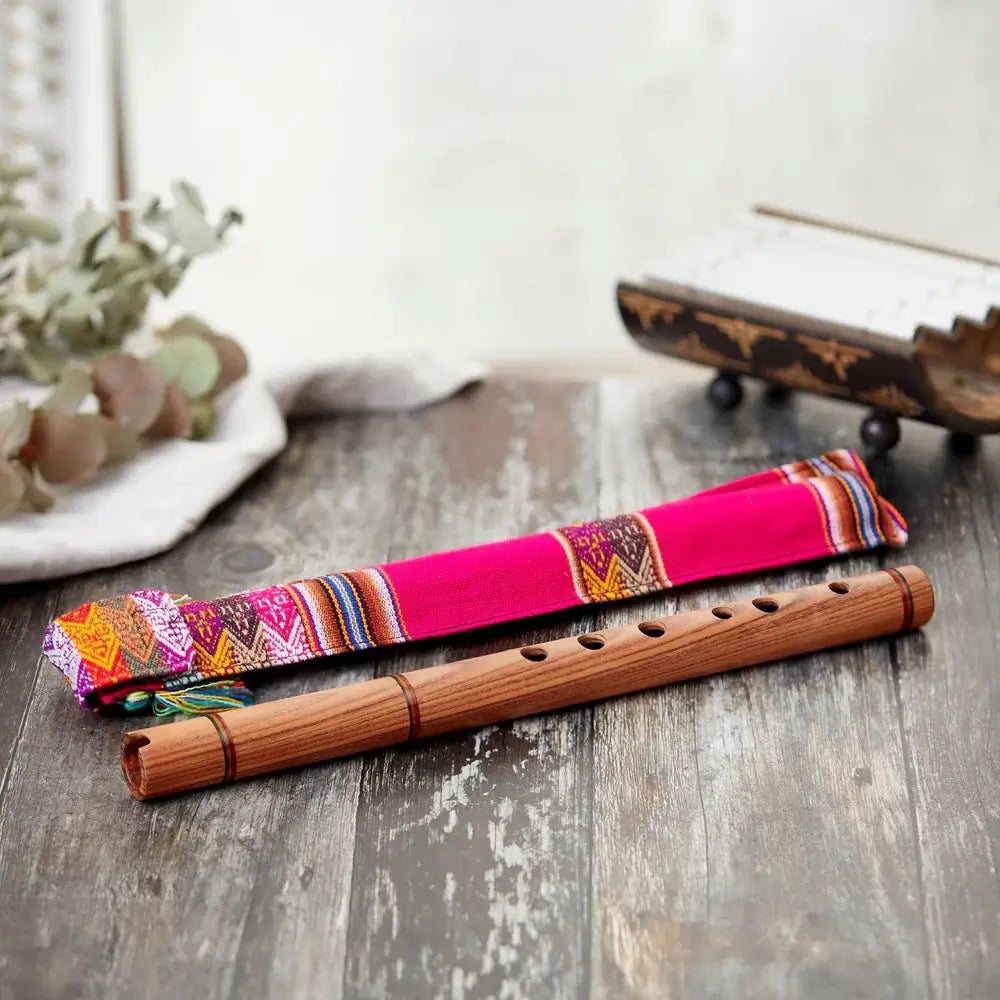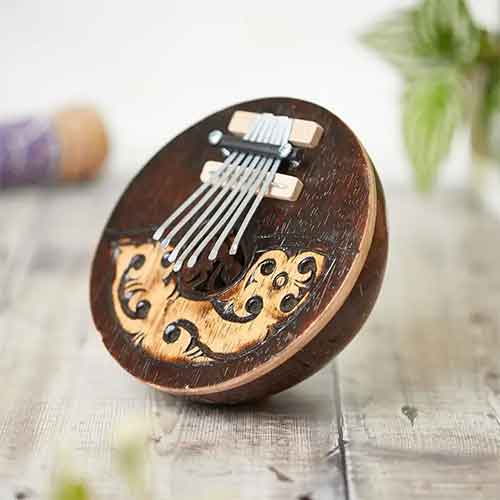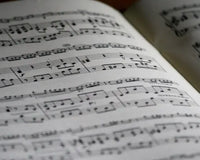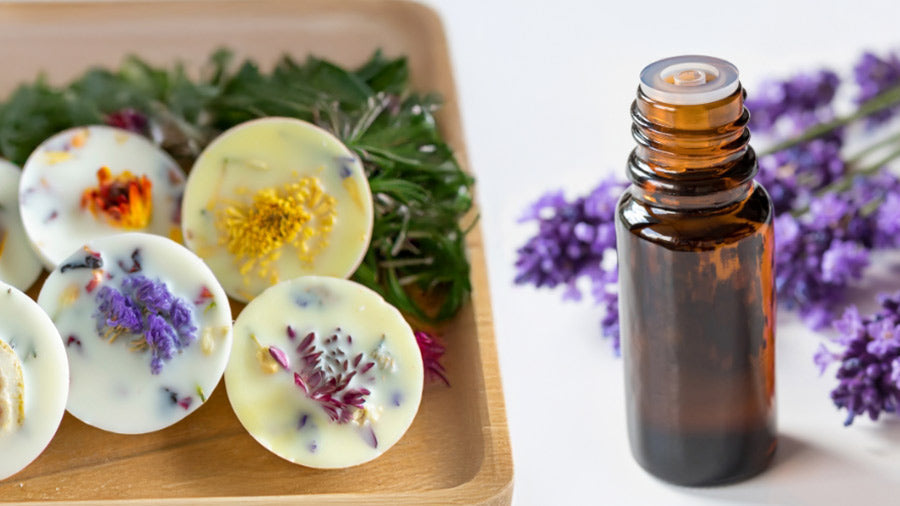The traditional daf drum is an ancient percussion instrument with strong cultural and spiritual ties, especially in Persian and Kurdish traditions. Its history dates back to ancient Persia, with early depictions found in the Elamite civilisation around the 7th to 8th centuries BCE. Over the centuries, it evolved into a key instrument used in spiritual practices, particularly within Sufi ceremonies, where it became essential to rituals and gatherings.
Typically, the daf is made with a circular wooden frame covered by animal skin, usually goat skin. The frame has metal rings inside it, which create the instrument's signature jingling sound. Depending on its size, the daf can produce a variety of tones that are suited for both musical and spiritual use.
The daf has held particular importance in Kurdish Sufi communities, such as the Qadiri and Yarsan orders, where it was played during sacred rituals. The role and sound of the daf continued to change over time, and in the 1970s, it experienced a revival in modern music, led by musicians like Mohammad Reza Lotfi and Bijan Kamkar. Today, it remains a beloved instrument in spiritual ceremonies and performances, continuing to be celebrated worldwide.
The origin of the Daf drum

The Daf drum's origins can be traced back to the Middle East, where it's primarily from. This percussion instrument is a staple in traditional music across a vast region that includes countries like Iran, Turkey, Afghanistan, and Armenia. Its presence is also notable in the Balkans, the Mediterranean, and Central Asia, illustrating the Daf's wide-reaching influence.
The Daf's roots are believed to be ancient, with some evidence suggesting that frame drums were used in pre-Islamic times. As Islam spread, the Daf found its way into religious ceremonies, especially within Sufi traditions, where it became a tool for spiritual elevation. The sounds of the Daf were believed to be a form of music that allowed people to connect with the divine and transcend the physical world.
The evolution of the Daf is as dynamic as the regions it represents. Each culture it touched added flavor to the instrument, resulting in various playing styles and construction methods that reflect the diversity of its origin stories. This rich background makes the Daf drum an instrument and a bridge between civilizations and epochs.
What makes the Daf drum different?
The Daf drum stands out for several reasons, the most notable being its size and the presence of metal rings attached to the inner frame. These rings add a jingle effect to the drum's sound, creating a unique combination of percussive beats and melodic chimes. This distinct feature sets the Daf apart from other frame drums and contributes to its versatile sound palette.
Another aspect differentiating the Daf is its ability to produce a wide range of sounds. The drumhead's tension can be adjusted, allowing for variations in pitch and tone. The techniques employed by Daf players involve striking the surface and manipulating the frame and rings.
The Daf is not merely an instrument; it's a canvas for expression. Its versatility has enabled it to adapt to various genres. Musicians appreciate the Daf for its dynamic nature, which allows it to be both a solo instrument capable of commanding an audience's attention and a collaborative tool that enhances performances.
Daf drum buying guide for beginners

When you decide to purchase a Daf drum, consider it an investment in not just a musical instrument but a piece of art. The process can be as enriching as learning to play the instrument itself. Several factors should be kept in mind to ensure you make an informed decision.
Quality of materials
Ensuring the quality of materials used in Daf construction is crucial. Traditionally, the frame is made of hardwood, contributing to the drum's durability and resonance. The drumhead, typically made from goat or fish skin, should be taut and blemish-free to ensure the best sound quality. Modern Dafs might also feature synthetic drumheads, which offer consistency and weather resistance.
The size
They come in various diameters, and the size can affect the pitch and volume of the drum. Beginners might prefer a smaller, more manageable size, while professionals might opt for a larger drum for a fuller sound. Additionally, the number of metal rings and their quality can influence the timbre and aesthetic appeal of the instrument.
Pricing
Cost is a practical aspect that cannot be ignored. The cost of Daf drums can vary widely based on factors such as how it was crafted, who made it, the materials used, and the reputation of the maker. While it might be tempting to opt for a cheaper option, remember that a higher-quality Daf will sound better and stand the test of time. Consider your budget and the instrument's value in terms of its construction, sound, and longevity.
Where to buy a Daf Drum?
The Daf drum, originating from the Middle East, offers a unique and versatile percussion experience. Its lightweight design makes it portable and easy to transport, allowing musicians to play it anywhere, from intimate gatherings to large performances. The Daf's tunable membrane provides a range of tones, allowing for music expressions. Its rich sound quality and dynamic range make it suitable for various genres, including traditional Middle Eastern music, world fusion, and contemporary compositions. The Daf's circular frame and intricate patterns contribute to its aesthetics for both performers and audiences. Discover our collection of Daf Drums here.
Daf Drum (Frequently Asked Questions)
What is a daf drum?
The Daf is a type of frame drum commonly found throughout the Orient. Historically, it's closely linked with Sufi ceremonies and rituals. Today, its distinct sound resonates across Middle Eastern and Oriental music scenes.
What are Sufi ceremonies and rituals?
Sufi ceremonies and rituals are spiritual practices within Islam's mystical tradition, Sufism. They involve prayer, meditation, chanting, and music aimed at achieving spiritual enlightenment and a deeper connection with the divine. These rituals often include group gatherings for reciting the names of God, rhythmic chanting, and movement, as well as zikr, poetry recitations, and dances led by a Sufi teacher. The goal is spiritual purification and union with the divine presence.
How does a daf sound?
The daf is renowned for its clear sound and deep tone. Often, dafs feature bells and plates on the sides, resembling a tambourine. Made from curved wood with animal skin stretched over it, the daf is similar to many hand drums.
What are its other names?
The daf, known by various names like def, duff, deff, defi, defli, or dap, is a large frame drum originating from the Persian tradition. It's commonly used alongside Iranian music and is also prevalent across the Middle East, including countries like Turkey, Armenia, and Azerbaijan, as well as reaching Siberia through Central Asia.
What is the daf drum made out from?
The frame of the daf is constructed from wood that has numerous metal rings inside it. Traditionally, the membrane of the daf is crafted from animal skin, such as goat, horse, or cow. However, modern versions may utilize synthetic materials. The frame itself is typically crafted from sturdy wood.

